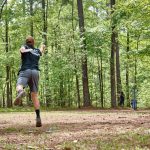Visualization is a powerful tool that can help improve your disc golf game. By using mental imagery, you can enhance your focus, confidence, and overall performance. In this article, we’ll explore the power of visualization and provide tips on how to use it to improve your game.
What is Visualization?
Visualization is the process of creating vivid mental images of a specific outcome or event. In the context of disc golf, visualization involves mentally rehearsing your shots, including the flight of the disc, the terrain, and the outcome. This technique has been used by athletes across various sports to improve their performance, and it can be just as effective for disc golfers.
How Does Visualization Work?
When you visualize a specific outcome, your brain processes the information as if it were real. This can lead to several benefits, including:
- Improved focus: Visualization helps you stay focused on your goals and avoid distractions.
- Increased confidence: By mentally rehearsing successful shots, you can build confidence in your abilities.
- Enhanced muscle memory: Visualization can help you develop muscle memory, which can improve your technique and overall performance.
- Reduced anxiety: Visualization can help you relax and reduce anxiety, which can be a major obstacle for many disc golfers.
How to Use Visualization for Disc Golf
Using visualization for disc golf is relatively simple. Here are some tips to get you started:
- Find a quiet and comfortable space: Sit or lie down in a quiet, comfortable space where you can focus on your visualization.
- Close your eyes: Close your eyes and take a few deep breaths to relax.
- Imagine the shot: Visualize the shot you’re about to take, including the disc’s flight, the terrain, and the outcome.
- Make it vivid: Use all of your senses to make the visualization as vivid as possible. See the disc flying through the air, hear the sound of it landing, and feel the rush of excitement.
- Practice regularly: Make visualization a regular part of your practice routine. Try to visualize specific shots or scenarios several times a week.
Additional Tips and Strategies
Here are a few additional tips and strategies to help you get the most out of visualization for disc golf:
- Use positive self-talk: Encourage yourself with positive affirmations, such as “I’ve got this” or “I’m a great disc golfer.”
- Focus on the process: Instead of focusing on the outcome, focus on the process of visualization. Imagine the disc flying through the air, the spin, and the landing.
- Visualize different scenarios: Don’t just visualize the same shot over and over. Try to visualize different scenarios, such as different discs, different terrain, and different wind conditions.
- Use visualization to overcome fears: If you’re afraid of a particular shot or scenario, use visualization to overcome those fears. Imagine yourself successfully completing the shot.
Conclusion
Visualization is a powerful tool that can help improve your disc golf game. By using mental imagery, you can enhance your focus, confidence, and overall performance. With regular practice and the right techniques, you can use visualization to take your game to the next level. Remember to stay positive, focus on the process, and use visualization to overcome fears and doubts.
FAQs
Q: Can anyone use visualization for disc golf?
A: Yes, anyone can use visualization for disc golf. Visualization is a technique that can be used by anyone, regardless of their skill level or experience.
Q: How often should I visualize?
A: It’s recommended to visualize several times a week, ideally before you play a round of disc golf. However, you can visualize as often or as infrequently as you like.
Q: Can visualization replace actual practice?
A: No, visualization should not replace actual practice. Visualization is a supplement to your regular practice routine, not a replacement. It’s still important to practice your technique and skills on the course.
Q: How long should I visualize for?
A: You can visualize for as long as you like, but it’s recommended to start with short sessions (5-10 minutes) and gradually increase the duration as you become more comfortable with the technique.
Q: Can visualization help with anxiety and nerves?
A: Yes, visualization can help reduce anxiety and nerves by allowing you to mentally rehearse successful shots and outcomes. This can help you feel more confident and focused on the course.








